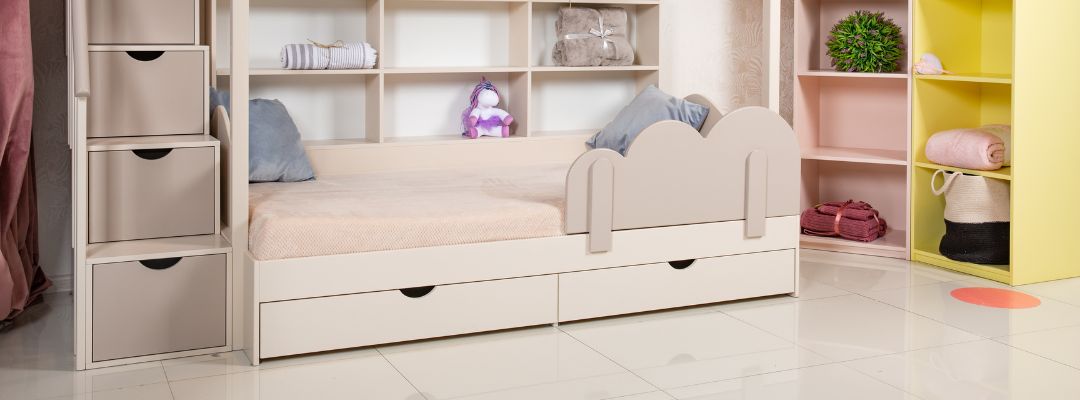Moving With Kids: The Step By Step Guide For Shift Easier

When you have kids to think about, moving to a new house may be a stressful and daunting experience. When moving with children, there are many things to take care of, from packing up your stuff to choosing a new school for your kids. However, you can make the process simpler and less intimidating for everyone involved with the appropriate planning and preparation. With the help of this step-by-step manual, you will learn how to organize and pack your stuff, get your family ready for the move, and help your kids adjust to their new environment more easily. This manual will assist you in navigating the process with confidence and simplicity, whether you’re relocating across the nation or just down the block.
How Moving Affects Your Kids

Moving can have a big influence on kids since it causes them to adjust to a new setting and disturbs their routines and familiar surroundings. During this shift, children may feel a variety of emotions, including worry, anxiety, and uncertainty. They could find it difficult to settle into their new house and neighborhood since they are upset about leaving their friends, family, and familiar surroundings behind. Children who move may experience academic difficulties in addition to emotional difficulties. Children who change schools may find it difficult to get used to the new teachers, classmates, and curriculum. It could be difficult for them to make up for missing coursework, make new friends, and engage in extracurricular activities in their new neighborhood.
For kids, losing a support structure can be a very difficult challenge. They could struggle to make new connections in their new community and feel cut off from their former friends and relatives. They may have emotions of loneliness and isolation as a result, which could be harmful to their emotional health. Therefore, it’s critical to recognize and address these possible difficulties if you want to aid your kids in adjusting to and integrating into their new neighborhoods and house.
Preparing Your Children Emotionally for the Move

Making the transition as easy as you can for your kids means preparing them emotionally for a move. Early conversational initiation is crucial to the success of this procedure. Your kids will be more ready for the relocation the more time they have to think about it and ask questions. Given that individuals can feel uncertain or nervous about the shift, it is crucial to pay attention to their worries and validate their feelings. You can reassure them that you’ll assist them adjust to their new home and support them during the house move.
Including your kids as much as you can in the process is another great suggestion. You can accompany them to check out prospective new residences or neighborhoods, allow them to assist with packing their stuff, and motivate them to take charge of their new surroundings. Your kids may feel more in charge of the situation and invest in the relocation as a result of their participation. Being upfront and honest with your kids about the transfer is also crucial. Promises you can’t keep can cause disappointment and mistrust, so try to avoid making them. Instead, focus on the advantages of the relocation, such as the new opportunities for development and adventure, and help your kids perceive the transfer as a thrilling new chapter in their lives.
Finding A New School and Transferring Your Children’s Records

Finding a new school and transferring your children’s records is an important aspect of moving with kids. Here are some tips to help you navigate this process:
- Research potential schools: Start by looking at the local schools. Find schools with a strong reputation, good student-to-teacher ratios, and extracurricular activities that your child is interested in participating in.
- Schedule visits: Plan visits to potential schools after you’ve narrowed down your list to have a look around and speak with administrators and teachers. You will gain a greater understanding of the school’s culture, curriculum, and suitability for your child as a result of doing this.
- Request transfer of records: Contact your child’s present school to request a record transfer once you’ve decided on a school. This includes any special education or medical data, test results, and academic transcripts.
- Meet with the new school: Set up a meeting with the new school to go through your child’s academic background and any potential special needs. This will make it more likely that the new school will be ready to offer your child the support he or she needs to succeed.
- Get involved: Your child should be encouraged to participate in extracurricular activities at their new school. They may meet new people as a result and feel more a part of their new neighborhood.
- Stay in touch: Throughout the transition, be sure to stay in touch with your child’s teachers and school officials. By doing this, you can make sure that any problems are resolved quickly and that your child is settling in well at their new school.
Tips for Moving with Kids by Age
Moving may be a difficult process, especially if you have kids. Parents must take into account the specific demands and requirements of each age group when relocating. There are specific suggestions and techniques that can assist everyone associated with the move to adjust as smoothly as possible, from infants and toddlers to school-age children. In this article, we’ll look at some of the best ways to relocate with children of various ages, including how to mentally and emotionally prepare them, locate a new school, and make the transition as easy as possible.
Tips for Moving with Babies and Toddlers
Moving with babies and toddlers can be particularly challenging, as they require a lot of attention and care. Here are some tips for making the move with babies and toddlers as stress-free as possible:
- Stick to routines: It’s crucial to keep infants and toddlers as close as you can to their regular routines when moving. Keeping a regular schedule might provide kids with a sense of stability and security during the chaos of moving. Even if it means adjusting your moving schedule to coincide with their nap periods, try to keep their eating and sleeping habits as similar to their regular schedule as you can.
- Bring along familiar items: Babies and toddlers frequently have comfort items that provide them with a sense of safety and security, such as a favorite blanket, stuffed animal, or toy. Ensure that you pack these things and have access to them during the transfer. During a period of change, they may feel more at ease and comfortable with familiar objects.
- Keep the sleep environment consistent: Toddlers who are accustomed to sleeping in their own beds may find moving to be particularly difficult. A portable cot, pack-and-play, or even their own mattress can be brought along to help establish a comfortable sleeping environment. Making their resting space comparable to what they are used to can ease their adjustment and make them feel more at ease.
- Take breaks: During the move, it’s crucial to take breaks so your kid may play, stretch, and get some energy out. Particularly toddlers may become agitated or grumpy if they are locked up for an extended period of time. The monotony of the journey can be broken up and made more tolerable for everyone by stopping for a playing break.
- 5. Get help: Get all the assistance you can because moving with infants and toddlers can be difficult. When it comes to daycare, think about asking friends or family members to assist with the move. It can be easier and less stressful for everyone if you hire a babysitter or nanny to watch your kid while you pack and unpack.
Tips for Moving with Preschoolers

Moving with preschoolers can be both exciting and challenging. Preschoolers may feel a range of emotions during the move, from excitement to anxiety. Here are some tips to make the move as stress-free as possible for both you and your preschooler:
- Involve them in the process: By including them in the planning and preparation, you may include your preschooler in the relocation. Discuss the relocation with them, go over the plan, and address any concerns they might have. Let them assist you in packing some of their belongings, such as their clothes or toys.
- Read books about moving: Your preschooler can better comprehend what is happening and what to anticipate by reading books about relocating. Look out for books on moving that are suitable for your child’s age and read them with them. After reading the book, talk about any queries or worries you may have.
- Create a special box: To prepare for the transfer, help your preschooler put together a special box of their favorite toys or belongings. This can provide them with a sense of control during the shift and give them something they are accustomed to.
- Maintain routines: Try to keep your regular schedule as much as you can because preschoolers thrive on routine. Both their regular daily schedules, such as mealtimes, and bedtimes, as well as their extracurricular pursuits, like sports or dance lessons, might be considered.
- 5. Plan for downtime: Plan for downtime throughout the relocation because toddlers may find the process daunting. Make time for your preschooler to play, unwind, and become comfortable in their new environment. This may lessen everyone’s stress during the changeover and the transfer.
Tips for Moving with School-Age Kids

Moving with school-age kids can be a significant transition for both the child and their parents. These suggestions will help the transition go as smoothly as possible:
- Involve them in the planning process: By including them in the planning and preparation, you can involve your school-aged child in the relocation. Consider allowing them to choose the furnishings for their new rooms and showing them images of the neighborhood and the new house.
- Research the new area together: As a family, research the new area’s activities, schools, and neighborhoods. Your child may become more enthusiastic about the relocation and feel more involved as a result of this. Think about going to the new location beforehand to explore and acquire a sense of the new surroundings.
- Say goodbye properly: Assist your child in properly saying goodbye to their former friends and neighbors. Think of organizing a farewell celebration or special activity, like a picnic or movie night.
- Pack a special box: Encourage your youngster to put their favorite belongings in a special box to bring with them when they move. Toys, literature, or other meaningful stuff to them can be included in this. When people move, having their sentimental items with them can make them feel more at home in their new location.
- Get involved in the new community: Encourage your youngster to participate in their new neighborhood by joining clubs, sports teams, or other organizations. They may meet new people and feel more at ease in their new surroundings as a result. To meet new people and get to know the new community, think about volunteering as a family.
Setting up Your Children’s New Room and Making It Feel Like Home

Making your children feel at home after a relocation requires setting up their new rooms. Include your child in the planning and decorating process to help create a cozy and welcoming atmosphere. Create a photo wall to showcase memories from your previous house and use familiar objects from it to infuse the new area with a sense of familiarity and connection. Encourage your child to decorate and personalize their new area with their own creations, and to add cozy touches like plush rugs, inviting seating, and an abundance of pillows and blankets. You may make your child’s transfer to a new house more fun and comfortable by taking the time to decorate their new room in a way that is reflective of their hobbies and personality.
Conclusion
Moving with children may be difficult and stressful for both parents and kids. However, with some forethought and preparation, it can also be a thrilling trip that strengthens your family bonds. You may ease the transition and make the move as easy as possible by incorporating your children in the planning process, doing research about the new region together, and taking steps to emotionally prepare your children. Additionally, you may encourage your kids to feel more at ease and enthusiastic about their new surroundings by following the advice for organizing their new rooms and getting engaged in the neighborhood. Moving with kids may be a wonderful and beneficial experience for your family if you have patience, are upbeat, and are willing to accept change. Hiring the right moving professionals will help you a lot in this. So you can consider hiring Harry The Mover to experience the budget-friendly and reliable moving in Melbourne.



